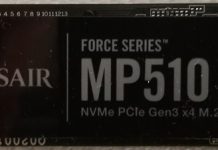|
|
Review: Toshiba OCZ RD400 M.2 NVMe 512GB Reviewed by: Wendy Robertson Provided by: Toshiba OCZ Firmware version: 1.02 |
OCZ is now fully integrated into the Toshiba Corporation,
with all the advantages and disadvantages of being part of a global giant. I
have very fond memories of the old independent OCZ who were the company that brought
SSDs to the masses, at truly affordable prices. They were always on the cutting
edge of SSD technology, and in most cases were first to bring new SSD
technology to the market. Being first to the market with a new technology also
had its disadvantages, and in OCZ’s early years in the SSD market, quite often SSDs
were launched that weren’t fully validated.
All this changed in later years, where SSDs such as the OCZ
Vector were both cutting edge, and properly validated before they were
launched. With OCZ now being fully integrated into Toshiba, the validation of
their products is among the best in the world. This does mean that OCZ are now slightly
later to the market with new products, but you can now be pretty sure that
these products are ready for primetime.
Consumer grade NVMe SSDs have been around for approximately
nine months, the first being the Samsung 950 Pro. There have been a few NVMe
SSDs launched during this period, but none until now have seriously challenged
the 950 Pro in terms of performance at an affordable price. Enter the new
Toshiba OCZ RD400 M.2 NVMe range of SSDs.
The Toshiba OCZ RD400 SSDs are available in capacities of
128GB, 256GB, 512GB, and 1024GB. Today I'm looking at the 512GB version of the
Toshiba OCZ RD400 M.2 NVMe SSD. Utilising the new NVMe (Non Volatile
Memory Express) interface. NVMe SSDs are PCIe based and are
installed in a standard PCIe slot, M.2 socket, or via the brand new U.2
connector. PCIe SSDs are not new, and have been around for several years.
However, the PCIe SSDs of the past required a special controller which sat
between the SSD hardware and the PCIe system bus, to allow the SSD hardware and
the PCIe bus to perform the translation and communication between the two
interfaces. This was of course a very complex and time consuming task, which
inevitably led to increased latency.
NVMe is a native solution, with its own highly optimised
protocol, which features a very much reduced command set, much lower latency when
compared to AHCI, and is specifically optimised for Non Volatile Memory (FLASH
memory).
Toshiba OCZ was kind enough to send me one of their brand
new RD400 M.2 series NVMe SSDs for review. In this case the 512GB M.2 NVMe
version.
So let's find out how this new SSD performs in our range of
tests.
Toshiba OCZ company information
Toshiba OCZ should need no introduction, but those of you
who would like to find out more about Toshiba OCZ, can do so at their website.
The Toshiba OCZ RD400 NVMe 512GB SSD
Packaging


Toshiba OCZ RD400 M.2
NVMe 512GB SSD mounted in the optional PCIe3 x4 adapter card

Toshiba OCZ RD400 M.2
NVMe SSD
The Toshiba OCZ RD400 M.2 NVMe SSD utilises a Toshiba
branded NVMe SSD controller, coupled with 512MB of LPDDR3 RAM as a cache. The
NAND is Toshiba’s own 15nm NAND in an MLC configuration.
Getting the best performance from the Toshiba OCZ RD400 will
require a native Hyper M.2 socket supporting PCIe gen3 x4. These are found in
most Z170 chipset, and X99 chipset motherboards.
Alternatively, you can mount the Toshiba OCZ RD400 M.2 NVMe
SSD on the optional PCIe3 to M.2 adapter card, and then plug this combination
into an X16 PCIe3 socket on the motherboard. However, your motherboard needs to
be capable of booting from NVMe in order to use this combination as your boot
device.
Drive maintenance features
For Windows 7, Windows 8, and Windows 10 users, and some
distributions of Linux, the Toshiba OCZ RD400 SSD supports TRIM to keep the
NAND clean. The Toshiba OCZ RD400 also has advanced garbage collection to clean
the NAND during drive idle periods.

OCZ SSD Utility
The SSD utility software allows the user to maintain the
SSD, and has the following features.
Overview tab
- Dashboard: Brings up useful information about the
SSD, including its health status and how much data has been written to the
SSD. It also displays how the SSD is connected, the firmware and NVMe
driver version and if any updated firmware or drivers are available. There
is also a handy temperature meter. - SSD details: Brings up more details about the SSD,
including its hardware ID string. - System details: Allows the user to see a mass of
information about the PC that the RD400 is connected to. - SMART: Displays the S.M.A.R.T. information of the RD400.
Tuner tab
- Benchmark: Performs a very basic benchmark on the
SSD. - SSD Tuner: Allows you to manually ‘over-provision’
the RD400. In other words, set aside an amount of NAND for the exclusive
use of the SSD controller. Using this feature will reduce the amount of
user storage. - OS Tuner: Allows operating system features that can
affect SSD performance, to be switched on or off.
Maintenance tab
- Updates: Allows the Toshiba OCZ RD400 firmware to
be updated. - Tools: Allows the SSD to be 'secure erased', clearing
all NAND and returning the SSD back to its default factory state. - Alerts: Displays any pending problem with the SSD,
or the system that it’s connected to. - Bootable SSD Utility: Allows the user to make a
bootable USB version of the SSD utility.
Settings tab
The settings tab allows the user to change various settings
in the OCZ SSD Utility. For example, if the monitoring part of the utility
should run in the background on closing the application, or if the OCZ SSD
Utility should be run automatically at Windows start up.
Help tab
The help tab creates a system report which can be saved as a
file, ready to be sent to Toshiba OCZ, should the user require technical
support from Toshiba OCZ.
Specifications.



Does the SSD support TRIM?
To allow TRIM to function you first need an SSD that
supports the TRIM command. You then need a storage stack that will allow the
TRIM command to pass-through to the SSD, and this includes the driver.
Thankfully this is now very easy to check with some degree
of reliability, using a small utility written by Vladimir Panteleev called TRIMCheck.

According to TRIMCheck, TRIM is functioning correctly on the
Toshiba OCZ RD400 M.2 NVMe 512GB SSD.
Let’s head to the next page where we take a look at our
testing methods and the review PC....

















